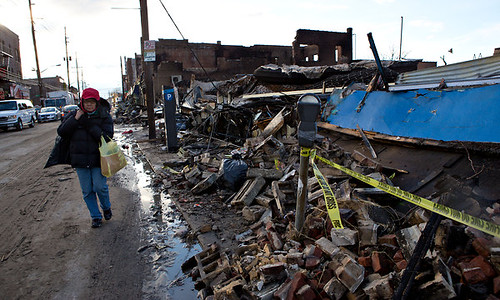
Aftermath of Hurricane Sandy in New York City. Tens of thousands remain homeless with millions more negatively impacted., a photo by Pan-African News Wire File Photos on Flickr.
Sandy disrupts voting; Northeast braces for new storm
10:28pm EST
By Daniel Trotta and Sharon Reich
NEW YORK (Reuters) - The aftermath of Superstorm Sandy created chaos and long lines at voting stations in the U.S. Northeast on Tuesday while officials braced for a new storm due to batter the region on Wednesday.
The former hurricane that walloped New York and New Jersey eight days ago continued to create misery for the thousands who lost their homes and 900,000 households and businesses that remained without power.
Voters casting ballots for the U.S. president endured confusion at makeshift polling stations. In New York City's Rockaways, a badly damaged barrier island community facing the Atlantic, people whose homes were damaged or lacked power went to vote in a tent.
"This is OK," said voter Alex Valger, comparing the polling place to near-freezing temperatures at home. "You ever try to sleep in a house where there is no heating control and the temperature outside is 34 (Fahrenheit)?"
In Brooklyn's Coney Island neighborhood, still far from recovered from Sandy's onslaught, voting had to be relocated from one school to another that lacked handicap access.
At least two voters had to be carried up the 17 steps, said Sally Stein, the polling place coordinator. Election board officials also made them relocate to another room halfway through the day because they considered the first room a fire hazard.
"I'm very disgusted today, very disgusted," Stein said.
Still crawling out the devastation of Sandy, the region braced for a smaller but powerful storm, a Nor'easter due to bring 60 mile-per-hour (95 km-per-hour) winds and a mix of rain and snow on Wednesday and Thursday.
Temperatures could dip toward freezing or below, and the National Weather Service issued high wind and coastal flood warnings.
New York City Mayor Michael Bloomberg ordered the evacuation of hundreds of nursing home residents and people living in low-lying areas such as the storm-ravaged Rockaways and Staten Island. Parks and beaches were to be closed during the storm.
The evacuation order affected more than 600 people at four health care centers operating on generators in the Rockaways in addition to private homes in the Rockaways and south shore of Staten Island, the borough where 22 people died out of the 40 that Sandy killed in New York City.
"A Nor'easter storm surge could compromise their generators, putting elderly residents at risk," Bloomberg said.
On the devastated Jersey Shore, a summer tourist haven where Sandy's storm surge swallowed whole neighborhoods and pushed entire homes across the street, the town of Brick issued a mandatory evacuation order for waterfront neighborhoods. The township of Middletown also ordered evacuations.
Sandy killed 69 people in the Caribbean before it moved north, combined with a strong North Atlantic system, and roared ashore on the New Jersey coast on October 29 as a rare hybrid superstorm.
It killed at least 120 in the United States and Canada and knocked out power to millions of people while swamping seaside towns and inundating New York City's streets and subway tunnels with seawater.
Many gas stations still lacked electricity or gasoline, and motorists endured long lines at the stations that were open. Fuel rationing was in force in New Jersey, where some residents hired school children to stand in line with gas cans.
Authorities reopened the Holland Tunnel linking Manhattan to New Jersey under the Hudson River, which stands to alleviate massive traffic jams on the roads and overwhelming crowds on public transportation systems that have yet to fully recover.
IMPACT ON THE POLLS
Officials confronted unprecedented challenges for Election Day across the region, where polling stations were among the thousands of buildings damaged by Sandy.
New York Governor Andrew Cuomo said New Yorkers would be able to vote at any polling place by presenting an affidavit. In New Jersey, those affected by Sandy will be designated as overseas voters, allowing them to cast ballots by fax or email as late as Friday.
The affidavit system created confusion and long lines were common.
"It's going to be thousands in here. We have seven poll sites combined into this one tent, so we have voters from all over the Rockaways coming here," said Stephen Thompson, a training specialist for the Board of Elections who was working in the tented polling place.
In Bay Head, New Jersey, most residents had to flee inland for shelter after Sandy wrecked their exclusive seaside community but many were returning on Tuesday so they could vote. Some drove for two hours to get to the firehouse polling station.
"We're very patriotic in this town," said longtime resident Joanne Pehlivanian. "We're going to vote no matter what."
The scene was more confused in the New Jersey town of Hoboken, on the Hudson River facing Manhattan, which was inundated with storm surge.
Hoboken voter Jake Stuiver, carrying his 2-year-old daughter Naomi, said he was turned away from his normal voting place and sent to an alternate location, where his name was not on the list of eligible voters.
"And I saw about four people who've had a similar experience," Stuiver said. "I'm carrying around a 2-year-old and she's cranky. We've been sleeping in different locations all week because we were evacuated, you know what I mean? ... I'm a very motivated voter in this town so I'm going to vote, but if that wasn't the case then I'm sure I'd have to move on to other things by now."
(Additional reporting by Jonathan Allen, Barbara Goldberg, Edith Honan, Philip Barbara, Chris Francescani, Kena Betancur and Sebastian Rocandio; Editing by Mohammad Zargham and Lisa Shumaker)
No comments:
Post a Comment